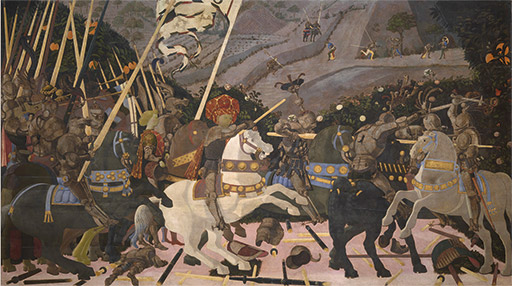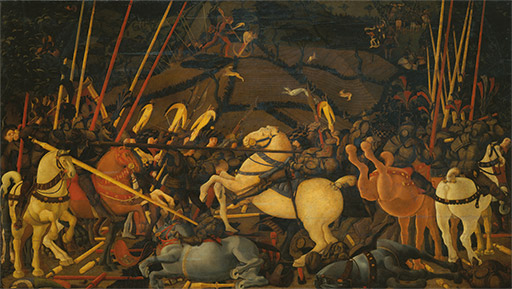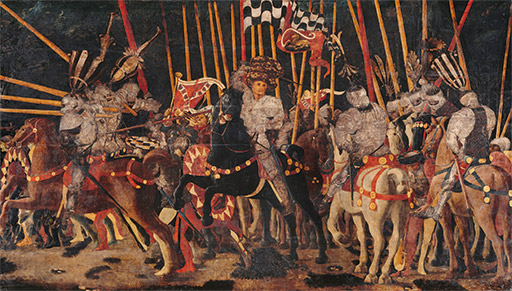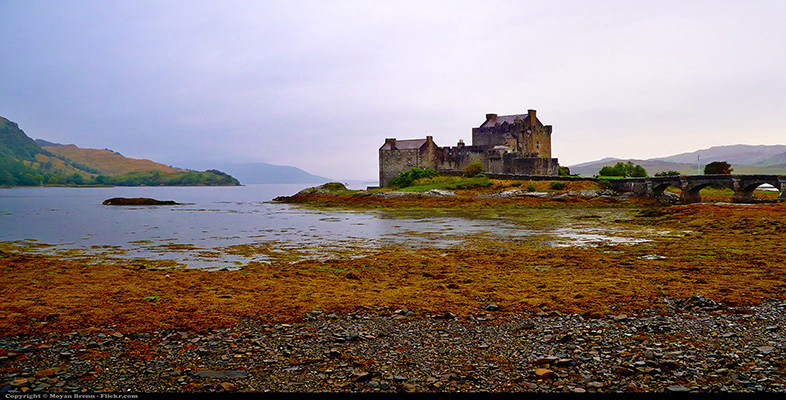The Medici as patrons and collectors
One example will suffice to illustrate the point. The legendary Medici family were self-styled rulers of Florence but not of noble, let alone royal, extraction, and hence the imperative of material ostentation was perhaps less powerful than it might have been, say, for a northern European king, and even inadvisable where the degree of magnificence was widely expected to correspond to social class. For this reason, despite their wealth, painting was arguably a medium in keeping with Medici status. Undoubtedly art lovers, the Medicis included in their private collection a rich variety of artistic media, from ancient artefacts and cameos to imported Byzantine miniature mosaics, goldsmiths’ work and Netherlandish tapestries, in addition to paintings. However, one incident in the career of Lorenzo de’ Medici, effective ruler of Florence from 1469 to 1492 and one of the patrons of Botticelli, illustrates the lengths to which Lorenzo was prepared to go to acquire coveted paintings.
The Battle of San Romano (Figure 4) by the Florentine painter Paolo Uccello (1397–1475) is one of the most canonical of Renaissance works of art. It is often chosen by art historians as an example of a Renaissance artist’s grasp of mathematical perspective with its carefully placed ‘fallen’ weapons and soldiers receding to a single vanishing point just to the right of centre, leading the eye on to the second picture in the series. It is the first of three paintings representing a famous victory of Florentine troops over the Sienese in 1432, led by the condottiere Nicolò da Tolentino. The second (Figure 5) shows the Sienese leader falling from his horse, and the third (Figure 6) shows Florentine troops attacking from the rear.



These three huge paintings were of a size and subject matter to warrant display in a public place as a commemoration of a famous victory and stimulus to Florentine patriotism. In fact, paintings of comparable secular subjects had been produced over a century earlier for precisely these motives, so the subject matter in itself does not signify a fundamental innovation. The painter Simone Martini contributed to a series of wall paintings of Sienese castles in the Siena town hall in the 1330s, apparently as a record of the military might of Siena. The San Romano pictures were designed for private viewing, however. Famously, they are recorded in 1492, displayed in the private room of Lorenzo de’ Medici in the Medici palace. As the de facto ruler of Florence, Lorenzo’s palace was presumably designed to impress visitors, and these victorious battle pictures could have been shown to a carefully selected few.
The Medici did not commission these battle scenes, however. They were originally owned by a wealthy Florentine family, the Bartolini Salimbeni. It appears that Lorenzo took advantage of his involvement in the division of the family property in 1483 to appropriate the pictures without the consent of at least one of the brothers. This in itself testifies to the value Lorenzo placed on adding the paintings to the Medici collection. In 1495, Damiano Bartolini Salimbeni brought an unsuccessful court case to get them back (see Gordon, 2003, pp. 390–1, and Roy and Gordon, 2001).
Originally designed to fill the arch-topped walls of a room, the pictures were in effect vandalised by the Medici, who cut them down at the top and built them up at the corners to make three rectangular paintings that could hang side-by-side, rather like tapestries. Battle scenes were a favourite subject for northern European tapestries, which may well have been too expensive to be within the grasp of the Bartolini Salimbeni family. The Medici could and did afford expensive tapestries imported from the Netherlands, so the fact that Lorenzo coveted these paintings appears symptomatic of the increasing enthusiasm for painting from the fifteenth century onwards.
